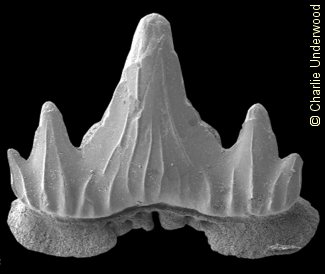 A A |
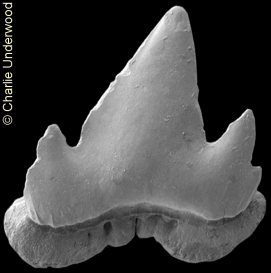 B B |
|
CARCHARHINIFORMES [Ground Sharks] |
|
|
Crassescyliorhinus (Underwood and Ward, 2008) |
Paratriakis (Herman, 1977) |
The Carcharhiniformes are represented in the Chalk by small Catfish / Dogfish forms with large numbers of very small clutching / cutting teeth. These are not typically recognised by the amateur collector, and data on these groups are generally drawn from specialist studies of microscopic material recovered from bulk sampling.
Included above is a full(?) listing of Carcharhiniform taxa recognised from the Chalk, to emphasise the 'hidden' diversity amongst the microscopic fraction of the Chalk shark fauna, in contrast with the relatively low-diversity larger forms, dominated by Lamniforms. Scyliorhinids are the commonest microscopic shark teeth in the Newhaven Chalk (where the Orectolobiform Chiloscyllium is not dominant) and Cretascyliorhinus is often common in the Grey Chalk.
The Carcharhinformes are highly diverse, but common tooth characteristics include: A very low root, separated from the crown by a constriction, notched on the labial face, with a broad base and a prominent nutritive cleft (vertical groove through the lingual protrusion); A very tall, slender and distally tapered main cusp; One or more pairs of accessory cusps; Crown surface smooth or ornamented by long, fine vertical ridges.
 A A |
 B B |
1). Scyliorhinus brumarivulensis - labial views of isolated anterior teeth from the Upper Santonian (Newhaven Chalk, Marsupites testudinarius zone) phosphatic chalk of Winterbourne, Berkshire: ((A) x40; (B) x45). Images figured in Underwood & Ward, 2008, and used here by kind permission of Charlie Underwood.
2). Scyliorhinus dubium - Detail of the holotype specimen displaying teeth (labial surfaces) preserved in life arrangement. Note the tooth top left showing a basal profile of the root. (x17, Grey Chalk, Kent, NHMUK (British Museum (Natural History) London) PV P47288). Image © 2012 The Natural History Museum, by kind permission.
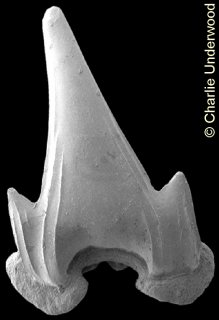 A A |
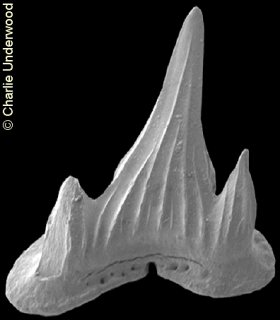 B B |
3). Scyliorhinus elongatus - labial views of isolated teeth from the Upper Santonian (Newhaven Chalk, Marsupites testudinarius zone) phosphatic chalk of Winterbourne, Berkshire: ((A) anterior tooth, x35; (B) lateral tooth, x50). Images figured in Underwood & Ward, 2008, and used here by kind permission of Charlie Underwood.
|
|
|
4). Scyliorhinus dubium - (A) part and (B) counterpart pieces of the holotype specimen, displaying remarkable preservation of the cartilaginous jaw parts, and with teeth preserved in or close to life arrangement (x2.6, Grey Chalk, Kent, NHMUK (British Museum (Natural History) London) PV P47288). Images © 2012 The Natural History Museum, by kind permission.
|
|
|
5). Scyliorhinus dubium - (A, B) Details of the holotype specimen displaying teeth preserved in or close to life arrangements ((A) x16, (B) x17, Grey Chalk, Kent, NHMUK (British Museum (Natural History) London) PV P47288). Images © 2012 The Natural History Museum, by kind permission.
|
|
|
6). Scyliorhinus antiquus - (A, B) part and (B) counterpart pieces of a specimen displaying remarkable preservation of the anterior portion of the body, including the cartilaginous elements of the head, and with associated teeth in close to life positions (x1.3, Grey Chalk, Burham, Kent, NHMUK (British Museum (Natural History) London) PV P5889). Images © 2012 The Natural History Museum, by kind permission.
7). Scyliorhinus antiquus - Detail of the anterior portion of the jaws with associated teeth, labial and lingual surfaces displayed (x7, Grey Chalk, Burham, Kent, NHMUK (British Museum (Natural History) London) PV P5889). Image © 2012 The Natural History Museum, by kind permission.
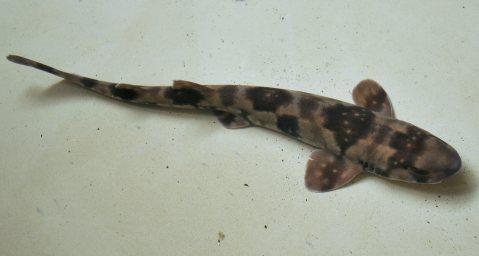 A A |
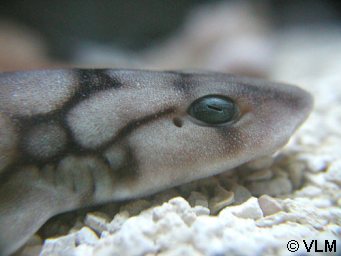 B B |
8). Modern Scyliorhinus for illustration: (A) S. torazame ('Cloudy Catshark') (image sourced from Wikipedia); (B) S. retifer ('Chain Catshark / Dogfish') (image sourced from Virginia Living Museum).